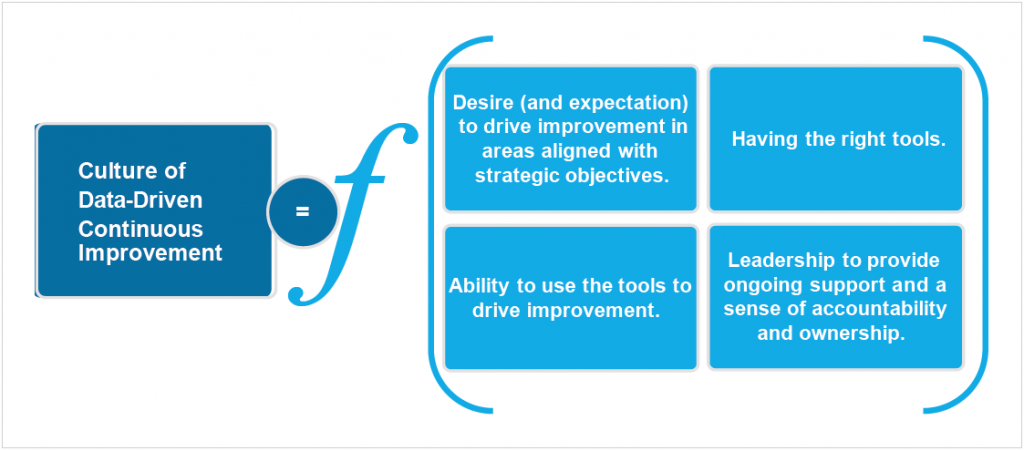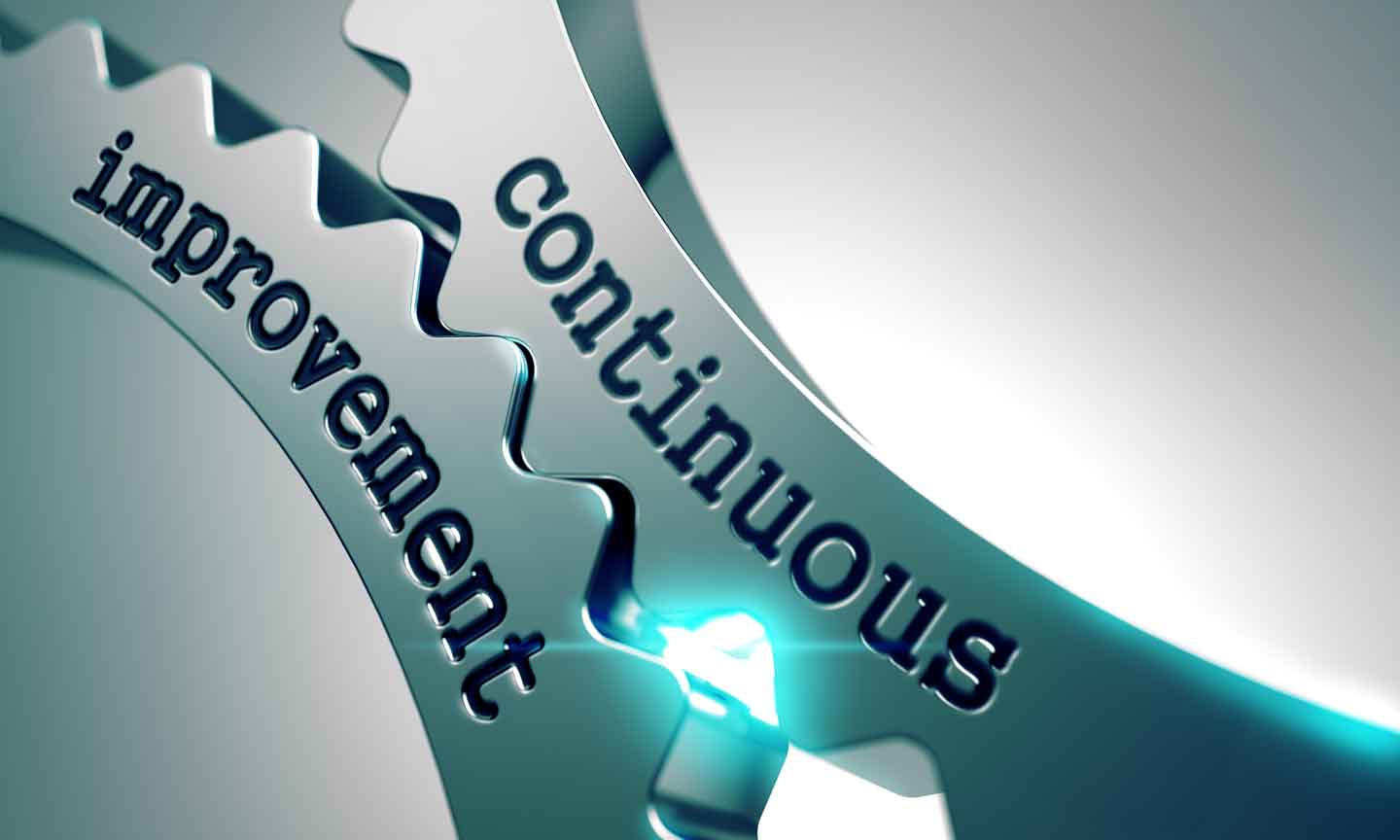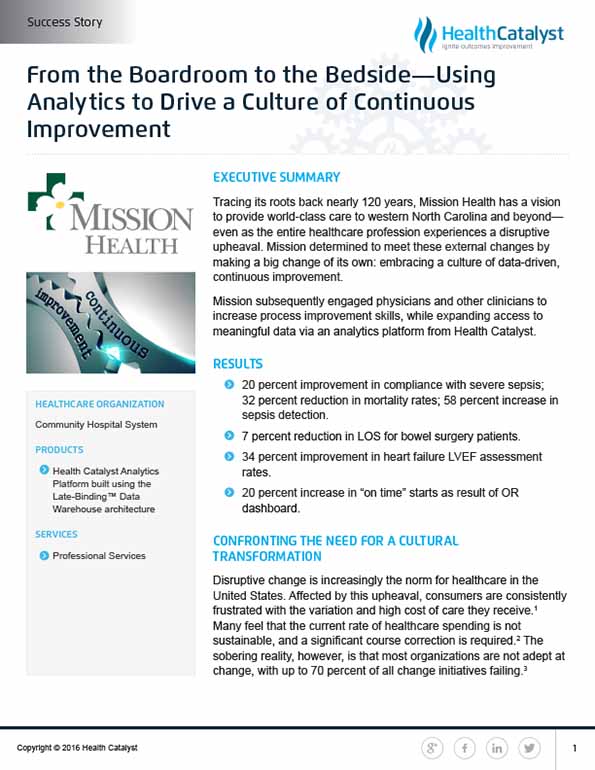Mission Health aims to provide exceptional care in western North Carolina amidst healthcare disruptions. To adapt, it has embraced a culture of continuous improvement by engaging physicians to enhance process skills and expanding access to data through its analytics platform.
Tracing its roots back nearly 120 years, Mission Health has a vision to provide world-class care to western North Carolina and beyond—even as the entire healthcare profession experiences a disruptive upheaval. Mission determined to meet these external changes by making a big change of its own: embracing a culture of data-driven, continuous improvement.
Mission subsequently engaged physicians and other clinicians to increase process improvement skills, while expanding access to meaningful data via an analytics platform from Health Catalyst.
Disruptive change is increasingly the norm for healthcare in the United States. Affected by this upheaval, consumers are consistently frustrated with the variation and high cost of care they receive.1 Many feel that the current rate of healthcare spending is not sustainable, and a significant course correction is required.2 The sobering reality, however, is that most organizations are not adept at change, with up to 70 percent of all change initiatives failing.3
However, there are also the inspiring examples of success. This story shines a light on how Mission Health, the Asheville, North Carolina-based healthcare system, transcended the odds of adapting to change and enacted a sweeping cultural shift. To date, this has helped decrease sepsis mortality rates within the health system by 32 percent, increased sepsis detection by 58 percent, and increased on-time surgery starts by 20 percent—which are just a few of the many significant improvements made.
Mission’s unwavering aim is to get every patient to their desired outcome—first without harm; then without waste; and always with an exceptional experience for each person, family, and team member. At the same time, it must adhere to the new models changing healthcare inside and out, including value-based and accountable care. Mission saw several opportunities for growth within its processes.
The difficulties Mission faced are common to many other health systems. In just one example, the surgery department had no insight into the percent of operating room (OR) cases that started on time, which is a common OR performance metric. When these cases don’t start on time, costs—and patient frustration—mount. Mission could get a retrospective report, but the delay in obtaining the data prevented its use as an improvement tool. In another example, while the emergency department tracked progress level metrics, this process was done manually by a single resource—making data access contingent on the availability of just one person. These challenges—whether self-imposed or government mandated—call for successful improvement processes. In this modern era, access to meaningful, actionable data is key to instilling a culture of continuous improvement, as well as monitoring and sustaining performance.
Data was abundant within Mission, but dispersed in 13 different EHRs, 12 different billing/finance systems, and 350 other IT applications. As such, much of this data was only accessible through the IT and Informatics departments, neither of which could easily provide real-time, operational data to hospital leaders. This hampered the ready use of data for improvement initiatives—but it wasn’t the only barrier to achieving a culture of continuous improvement.
Mission had the advantage of a highly skilled and effective team of process engineering professionals. Over time, however, dependency on this core team for complex process improvements became entrenched. This greatly limited the speed and scale of the kind of organizational change that Mission sought.
Ultimately the health system wanted a new way to use system wide data, one that could achieve differing aims—from broad access for analyses to operational use, such as daily unit management and boardroom discussions.
Big changes often require a multipronged approach. To drive transformational change at Mission, the health system drew on resources from different fronts, all integral to changing entrenched perspectives and practices.
Instilling transformational culture change. To be successful, Mission understood it needed to instill a culture of continuous, data-driven improvement, engaging front line staff, leaders, and executives (see Figure 1). Mission laid the groundwork for this new environment by making it clear that part of each employee’s job is to make that job better. Mission assured its employees they would be empowered and enabled to do so.

Mission then changed its approach to establishing strategic objectives, making sure that analytics are ready and available to support each objective on an annual basis. Using a sophisticated process that assesses a proposed objective’s potential return on investment, IT staff at Mission effectively prioritize allocation of resources. Once established, strategic objectives are reviewed at least every 90 days, helping to eliminate unplanned delays. This approach accelerates improvement and increases adoption.
Continuous improvement training was provided for specific, targeted roles with accountabilities for executing improvement projects outside of the performance improvement. Rather than develop only five or six Lean green/black belts, Mission trains a much greater number of employees, and focuses on team-based care. In addition to team development courses, trainees take a Lean essentials course. Developed in collaboration with nursing and operational leaders, the course provides frontline staff and leaders the necessary skills and tools for process improvement.
Training and coaching is also provided to IT/Business Intelligence staff, assisting analysts in developing skills to better understand processes of care and user needs. The goal is to help them become advocates and effective partners in problem solving—data scientists, not just report builders.
Finally, Mission made certain that leadership was prepared to provide ongoing support and a sense of accountability and ownership. Mission sought to provide their employees the best possible tools to reach their goals.
Analytics underpin continuous data driven improvements. Mission knew that continuous, data-driven improvements require analytics. However, with much of Mission’s data siloed in different systems it was nearly impossible to set effective goals, assess current performance, evaluate progress—and celebrate successes. It also left gaps in the data, a recurring issue in many hospitals. These limits hampered initiatives that could improve important metrics such as on-time surgery starts and emergency room performance.
To be the most effective, Mission needed ongoing, near real-time data and analytics. Following careful evaluation of potential options, Mission elected to partner with Health Catalyst and install the Health Catalyst Analytics Platform, built using the Late-Binding™ Data Warehouse architecture (EDW). In addition to its technology, Health Catalyst brought a sophisticated methodology to data management that helped Mission turn its own data into a valuable organizational asset. Health Catalyst also had skills and expertise in enabling health systems to implement Care Process Models (CPMs) that set the standard for care within their organizations.
Process engineering drives change and adoption. Mission took a fundamentally different approach to the installation of the EDW and analytics platform, making sure it was not just another IT project. Instead, the health system emphasized collaboration between physicians, executives, leadership, and IT to drive decision making and the overall implementation. This established a sense of ownership among all key stakeholders.
Meanwhile, the EDW was deployed in concert with CPMs where the need for data access was the greatest. Staff were held accountable for CPM adherence, with incentive compensation tied to outcomes.
Mission also worked on empowering leaders, with a special focus on physicians. Rather than relying on a small team from the process improvement department, improvement teams are now multidisciplinary (physician, nursing, administration, performance management experts, process engineers, etc.). These teams each have clear accountabilities to ensure improvement.
Finally, to assure accessibility of meaningful, actionable data for improvement, Mission expanded access to the analytics tools beyond IT.
Committed to making data-driven decisions, Mission has put appropriate protections in place to assure confidentiality of patient information, while making meaningful data available to everyone, not just leaders. This approach has helped increase peer-to-peer learning and organizational capacity for improvement.
In a compelling example, a highly empowered sepsis improvement team—comprised of emergency and critical care physicians, a clinical nurse specialist, knowledge engineer, and data scientist—identified that patients who had care ordered via an evidence-based order set had survival rates that were 2.5 times higher than patients who did not have care ordered via an order set. When an emergency physician from the team shared this data with other emergency physicians, order set utilization immediately increased.
Mission Health’s transformational journey to instill a culture of continuous improvement has created an environment where ongoing process improvement is embodied within the organization and workforce. Rather than relying on one small team to facilitate improvement, 11,000 Mission employees are now empowered to improve care processes. As a result, Mission has realized impressive improvements in the use of the EDW, CPMs, and in advanced analytics.
“As we started to use advanced analytic applications and demonstrate improvement with specific Care Process Models, use of analytics across the system increased.”
– Jonathan Brown, MBA, CIO, Mission Health System
Mission is continuing to advance a culture of data informed continuous improvement. Future priorities and work in progress includes careful integration of analytics use and application development skills to roles outside of the IT analytics team to create continued opportunity and capacity for process improvement. It also helps shift the current centralized model to a federated approach, which Mission believes will help the health system meet business needs faster and deliver multiple projects at a time. Mission also plans to integrate advanced analytics into an operational dashboard to include predictive and prescriptive controls.
With the above enhancements, Mission intends to execute a hospital census prediction, further develop and implement more CPMs, and integrate analytic applications into the provider workflow.




